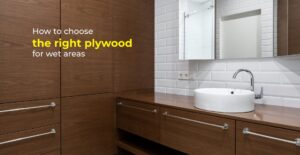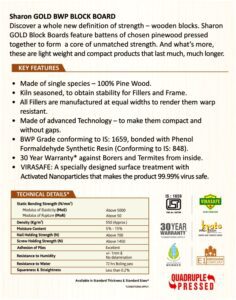

When you are building or designing an interior, fire safety must be taken into account. One material that has become increasingly popular for enhancing fire safety is fire-retardant plywood. This blog post explores the various uses of fire-retardant plywood in construction and interior design, highlighting its benefits and applications.
Fire-retardant plywood is treated with chemicals that help it resist ignition and slow the spread of flames, making it an excellent choice for applications where fire safety is a priority. The fire-resistant treatment can be applied during the manufacturing process or afterwards, ensuring that the plywood meets specific fire safety standards.
The primary benefit of fire-retardant plywood is its ability to improve fire safety by slowing the spread of flames and reducing smoke production. This makes it a valuable option for enhancing fire protection in various settings.
Fire-resistant plywood can be used in a variety of applications, from structural components to interior finishes, proving its adaptability across different project needs.
Treated plywood retains its strength and durability, making it a reliable choice for both construction and design projects. It provides long-lasting performance while maintaining its fireproof properties.
Using fireproof plywood helps meet building codes and fire safety regulations, offering peace of mind for builders and occupants alike.
In structural applications where fire protection is essential, fire-resistant plywood is frequently employed. This includes framing, subflooring, and load-bearing walls. Its strength and fire-resistant properties make it ideal for these critical components of a building.
Framing forms the skeleton of a building, and using fire-retardant plywood in this application can significantly enhance the structure’s overall fire resistance. This is particularly important in multi-story buildings, where fire safety is a top priority.
Subflooring provides a stable base for flooring materials and contributes to the structural integrity of a building. Fire-resistant plywood used in subflooring helps prevent the spread of fire between floors, adding an extra layer of protection.
Using fireproof plywood for wall and ceiling panels enhances the overall fire resistance of a building. These panels help contain fires and prevent them from spreading quickly, providing valuable time for evacuation and firefighting efforts. They also contribute to the structural stability of walls and ceilings, making them a dual-purpose solution for safety and durability.
Fire-retardant plywood is also used in roofing applications, particularly in areas prone to wildfires or where building codes require enhanced fire resistance. This type of plywood can help prevent roof fires and protect the structure below. Its ability to resist ignition from external fire sources, such as embers and sparks, makes it an essential material for safe roofing solutions.
One of the best materials for building furniture is fire-resistant plywood. It offers the same workability and aesthetic appeal as regular plywood but with the added benefit of enhanced fire safety. This makes it a popular choice for furniture in public spaces, such as schools, hospitals, and commercial buildings.
In public spaces, fire safety regulations are stringent, and the use of fire-retardant materials is often mandated.
In kitchens and other areas where fire risk is higher, fire-resistant plywood is used for cabinetry. It provides a safer option without compromising on design or functionality. Fire-retardant cabinets are key components in creating a safer living or working environment.
Kitchen cabinets made from fire-retardant plywood offer protection against potential fire hazards, such as stovetop flare-ups or electrical fires. This added safety feature can be critical in preventing small fires from spreading quickly.
Bathrooms, especially those with electrical fixtures and heat sources, benefit from fireproof cabinetry. In addition to improving safety, these cabinets keep their structural integrity in damp and humid environments.
Decorative panels made from fire-retardant plywood are used in various interior design applications, including wall coverings, partitions, and ceiling treatments. These panels combine aesthetic appeal with enhanced fire safety, making them suitable for both residential and commercial spaces.
Fire-resistant plywood wall coverings add a layer of safety to any room while providing a beautiful, finished look. These panels can be used in hallways, living rooms, and offices to enhance both aesthetics and fire safety.
Partitions made from fireproof plywood are ideal for creating separate spaces within larger areas, such as offices or open-plan homes. These partitions offer fire resistance, ensuring that any potential fire is contained within smaller sections.
Ceiling treatments using fire-resistant plywood can provide a sophisticated finish to rooms while improving fire safety. These treatments are especially beneficial in commercial spaces where fire codes are strict.
When using fire-retardant plywood, it’s essential to ensure compliance with local fire safety regulations and standards. These regulations vary by region and building type, so it’s crucial to consult with local authorities and industry experts to determine the specific requirements for your project. Compliance with these standards not only enhances safety but also ensures that the building meets legal requirements.
Sets standards for fire safety in construction and interior design.
Provides guidelines for building safety, including fire-resistant materials.
Certifies materials and products for fire safety.
Fire-retardant plywood can be an environmentally friendly option when sourced from sustainably managed forests and treated with low-toxicity fire-retardant chemicals. Look for certifications such as FSC (Forest Stewardship Council) or SFI (Sustainable Forestry Initiative) to ensure that the plywood used in your project meets environmental standards. Additionally, consider the impact of the fire-retardant chemicals used and choose products that are low in volatile organic compounds (VOCs) to minimize indoor air pollution.
Fire-retardant plywood such as SharonPlatinumPly and SharonGOLD Marine Plywood are versatile and valuable materials for both construction and interior design, offering enhanced fire safety without compromising on strength, durability, or aesthetic appeal. Its applications range from structural components to decorative finishes, making it a practical choice for a variety of projects. By understanding the benefits and uses of fire-resistant plywood, builders, and designers can make informed decisions that enhance safety and comply with fire safety regulations. Whether you’re constructing a new building or renovating an existing space, Firesave plywood from SharonPly can provide the added protection needed to create a safer environment.










Users understand that SHARONPLY is committed to protecting the User’s privacy and shall take all efforts to protect any personal data provided to the Website by reasonable security safeguards against such risks as loss or unauthorised use, destruction, modification or disclosure of data, However, in case of any lapse, SHARONPLY shall not be held responsible for any effect or consequences thereof. The Website uses cookies to track usage of the path of the User. Since most web browsers automatically accept cookies, User can edit User’s browser options to block them if User does not want the Website to use cookies to track usage of the path of the User.
SHARONPLY undertakes not to disclose, except as otherwise provided, the personal information provided by the User to any person, unless such action is necessary to: –
By filling up any form on the Website User automatically grants SHARONPLY a royalty-free, perpetual, irrevocable non-exclusive license to use, reproduce, publish, edit, distribute, and publicly display the information given in the form and to sublicense such rights.
Any queries regarding the SHARONPLY’s privacy policy, may be sent to admin@sharonply.com.

